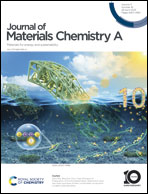Defect engineering in MIL-125-(Ti)-NH2 for enhanced photocatalytic H2 generation†
Abstract
Pre-designing starting materials is a sensible approach to tailor the synthetic, optoelectronic, and physicochemical properties of a photocatalyst towards higher activity without the need for additional active species. MIL-125-(Ti)-NH2, a metal–organic framework (MOF) photocatalytically active for H2 evolution, was first successfully synthesised at a relatively low temperature of 70 °C upon employing pre-designed titanium-oxo-carboxylate clusters. While rearrangement of the original cluster enabled successful MIL-125-(Ti)-NH2 formation, its ligand stoichiometry favoured MOFs with abundant “defects” at the Ti centres which in turn acted as accessible active sites for H2 generation. The catalytic sites and their local geometry were studied by pyridine-adsorbed Fourier transform infrared spectroscopy, X-ray absorption near-edge structure, and extended X-ray absorption fine structure. Interestingly, the frameworks prepared using pre-designed titanium-oxo clusters can alter electronic optical properties and energy levels. In the presence of triethanolamine as an electron donor and under visible light irradiation, this led to a ∼3.5 times higher H2 evolution rate in the titanium-oxo cluster MOF compared to MIL-125-(Ti)-NH2 obtained by typical hydrothermal synthesis. The obtained catalyst also exhibits a good-reusable performance for at least three consecutive runs without any loss in its reactivity. Pre-designed clusters can be simply utilised to generate accessible active sites and manipulate electrical properties for enhancing catalytic performance.



 Please wait while we load your content...
Please wait while we load your content...